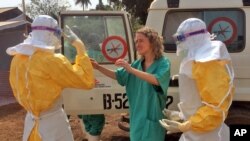WASHINGTON —
The strain of Ebola virus that has killed 121 people in West Africa may have been circulating there undetected for some time, according to a new study.
This is the first reported outbreak of Ebola in West Africa. But the new study in the New England Journal of Medicine said this strain of the virus may not be new to the area.
Researchers from Africa and Europe compared viral DNA from this outbreak to previous episodes.
They confirmed that it is a member of the Zaire species, which kills most of its victims. Strains of that virus have caused outbreaks previously in Gabon and the Democratic Republic of Congo.
But this virus is a new strain, a previously unknown sister in the Zaire family.
Virologist Jens Kuhn at the National Institutes of Health said there may be more.
“There might be a lot of variety in these viruses. They might be in many different countries in West Africa and East Africa where we have not heard anything of outbreaks so far,” said Kuhn.
Kuhn was not part of this research. He leads the top NIH lab studying the world’s most dangerous viruses, and he is working on ways to treat and prevent infection with them. Kuhn said there is a lesson in this outbreak.
“This is a warning that the variability of these viruses is greater than we knew. And so it’s very important that we develop something that is broadly based and not protects only against a particular virus that we knew of before,” said Kuhn.
Right now, the best protection is to avoid contact with blood or bodily fluids from an infected person.
This is the first reported outbreak of Ebola in West Africa. But the new study in the New England Journal of Medicine said this strain of the virus may not be new to the area.
Researchers from Africa and Europe compared viral DNA from this outbreak to previous episodes.
They confirmed that it is a member of the Zaire species, which kills most of its victims. Strains of that virus have caused outbreaks previously in Gabon and the Democratic Republic of Congo.
But this virus is a new strain, a previously unknown sister in the Zaire family.
Virologist Jens Kuhn at the National Institutes of Health said there may be more.
“There might be a lot of variety in these viruses. They might be in many different countries in West Africa and East Africa where we have not heard anything of outbreaks so far,” said Kuhn.
Kuhn was not part of this research. He leads the top NIH lab studying the world’s most dangerous viruses, and he is working on ways to treat and prevent infection with them. Kuhn said there is a lesson in this outbreak.
“This is a warning that the variability of these viruses is greater than we knew. And so it’s very important that we develop something that is broadly based and not protects only against a particular virus that we knew of before,” said Kuhn.
Right now, the best protection is to avoid contact with blood or bodily fluids from an infected person.






